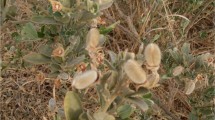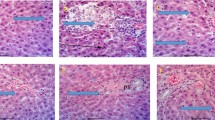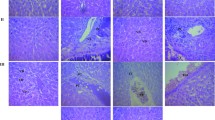Abstract
Anchomanes difformis is a rhizomatous herb that is commonly used in traditional medicine for the treatment of various diseases. However, there are reports of its toxicity to animals at certain concentrations. The present study was therefore designed to study the potential toxic effects of A. difformis on the liver and kidney of Wistar rats by using various biochemical indices and histopathology. The rats were divided into five groups (I–V) and were treated as follows: group I (negative control); groups II, III, and IV had 1, 2.5, and 5% of A. difformis respectively included in their diets; and group V (positive control) had 5% permethrin in their diets. The experimental treatment lasted 30 days after which the animals were sacrificed, and the blood collected for the determination of serum levels of aspartate aminotransferase (AST), alanine aminotransferase (ALT), alkaline phosphatase (ALP), urea, and creatinine. The liver and kidney were excised for histopathological and biochemical analyses. The serum levels of AST, ALT, ALP, urea, and creatinine were significantly higher in rats that were maintained on diets that contained 5% A. difformis and 5% permethrin compared to those maintained on basal diets, 1 or 2.5% A. difformis. On the other hand, the liver and kidney levels of AST, ALT, ALP, urea, and creatinine were significantly lower in rats that were maintained on diets that contained 5% A. difformis and 5% permethrin compared to those maintained on basal diets, 1 or 2.5% A. difformis. Also, maintenance of rats on diets that contained 5% A. difformis and 5% permethrin resulted in apparent damage to the liver and kidney. This study has shown the level of safety of A. difformis on mammals; it is both hepatotoxic and nephrotoxic at high levels; therefore, caution must be applied when using the plant as herbal medicine.


Similar content being viewed by others
References
Abdallah EM, Khalid HE, Al-Khalifa KS (2009) Toxicological assessment of the oleo-gum resins of Commiphora molmol and Boswellia papyrifera in rats. J Med Plant Res 3:526–532
Adegoke EA, Akinsanya A, Naqvi SHZ (1968) Studies of Nigeria medicinal plants: a preliminary survey of plant alkaloids. J West Africa Sci Assoc 13:13–33
Adeleke O, Adetunji T (2010) Antimicrobial activity of Anchomanes difformis (Blume) Engl (family ARACEAE). acta SATECH 3:87–90
Akah PA, Njike HA (1990) Some pharmacological effects of rhizome aqueous extract of Anchomanes difformis. Fitoterapia 61:368–370
Akinkurolere R, Adidire C, Odeyemi O (2006) Laboratory evaluation of the toxic properties of forest Anchomanes, Anchomanes difformis against pulse beetle Callosobruchus maculatus (Coleoptera: Bruchidae). Insect Sci 13:25–29
Akparie SO (2004) , 1 Stirling—Horden publishers (Nig.) Ltd. 136 p
Ataman J, Idu M (2015) Renal effects of Anchomanes difformis crude extract in Wistar rats. Avicenna J Phytomed 5:17–25
Atawodi SE, Bulus T, Ibrahim S, Ameh DA, Nok AT, Mamman M, Galadima M (2003) In vitro trypanocidal effect of methanolic extract of some Nigerian savannah plants. Afr J Biotechnol 2:317–321
Bancroft JD, Cook HC (1994) Manual of histological techniques and their diagnostic application. Churchill Livingstone, Edinburgh 457pp
Dalziel JM (1937) Useful plants of West tropical Africa. Crown Agent, London, pp 480–481
Egwurugwu JN, Ohamaeme MC, Chinko BC, Ebuenyi MC, Akuneh-Wariso CC, Ngwu EE, Ugwuezumba PC, Ezekwe SR (2017) Effects of extract of Anchomanes difformis on haematological parameters of albino Wistar rats. Int Res J Medical Sci 5:1–6
Farnsworth NR (1966) Biological and phytochemical screening of plants. J Pharm Sci 55:225–276
Frausin G, Lima RBS, Hidalgo AF, Ming LC, Pohlit AM (2015) Plants of the Araceae family for malaria and related diseases: a review. Rev Bras Plantas Med 17:657–666
Ileke KD, Oni MO (2011) Toxicity of some plant powders to maize weevil, Sitophilus zeamais (Coleoptera: Curculionidae) on stored wheat grains. Afr J Agric Res 6:3043–3048
Ileke KD, Odeyemi OO, Ashamo MO, Oboh G (2014) Toxicological and histopathological effects of cheesewood, Alstoonia boonei de wild stem bark powder used as cowpea proctectant against cowpea bruchid, Callosobruchus maculatus (Fab) [ Coleoptera: Chrysomelidae] on albino rats. IFE J Sci 16:23–33
Kanu KC, Ijioma SN, Atiata O (2016) Haematological, biochemical and antioxidant changes in Wistar rats exposed to dichlorvos based insecticide formulation used in Southeast Nigeria. Toxics 4:28
Kim H-S, Miller DD (2005) Proline-rich proteins moderate the inhibitory effect of tea on iron absorption in rats. J Nutr 135:532–537
Mossa AH, Swelam ES, Mohafrash SMM (2015) Sub-chronic exposure to fipronil induced oxidative stress, biochemical and histopathological changes in the liver and kidney of male albino rats. Toxicol Rep 2:774–784
Nwosu LC, Adedire CO, Ogunwolu EO, Ashamo MO (2017) Toxicological and histopathological effects of Dennettia tripetala seeds used as grain protectants, food and medicine. Food Qual Saf 1:211–219
Oghale OU, Idu M (2016) Phytochemistry, anti-asthmatic and antioxidant activities of Anchomanes difformis (Blume) Engl. leaf extract. Asian Pac J Trop Biomed 6:225–231
Okpo SO, Ching FP, Ayinde BA, Udi OO, Alonge PO, Eze GO (2011) Gastroprotective effects of the ethyl acetate fraction of Anchomanes difformis (Engl). Int J Health Res 4:155–161
Okpo SO, Ayinde BA, Ugwa ZI, Ching FP, Alonge PO, Udi OO (2012) Anti-ulcer activity of the aqueous extract of Anchomanes difformis. Nig Journ Pharm Sci 11:58–65
Okpo SO, Ozolua R, Ching FP, Eze GO (2013) Acute and short term toxicity studies on the aqueous extract of Anchomanes difformis. Nig Journ Pharm Sci 12:1–10
Ovuakporie-Uvo O, Idu M, Eze GO, Ozolua RI (2015) Toxicological studies of Anchomanes difformis Blume (Araceae) using rats and mice. Int J Basic Clin Pharmacol 4:1228–1234
Oyetayo VO (2007) Comparative studies of the phytochemical and antimicrobial properties of the leaf, stem and tuber of Anchomanes difformis. J Pharmacol Toxicol 2:407–410
Podolak I, Galanty A, Sobolewska D (2010) Saponins as cytotoxic agents: a review. Phytochem Rev 9:425–474
Author information
Authors and Affiliations
Corresponding authors
Ethics declarations
Conflict of interest
The authors declare that they have no conflicts of interest.
Ethical approval
All applicable international, national, and institutional guidelines for the care and use of animals were followed.
Rights and permissions
About this article
Cite this article
Adebo, C.T., Adeyemi, J.A. & Adedire, C.O. Biochemical and histopathological effects of a bioinsecticide, Anchomanes difformis (Blume) Engler rhizome powder on Wistar rats. Comp Clin Pathol 27, 1545–1550 (2018). https://doi.org/10.1007/s00580-018-2771-9
Received:
Accepted:
Published:
Issue Date:
DOI: https://doi.org/10.1007/s00580-018-2771-9




